

Last updated: May 2017
In the highly dynamic, fast moving world of Intranets and Digital Workplaces, the need for orientation understandably is a big one. Where does my organization stand? Where does the journey need to go?
This overview of Intranet and Digital Workplace Maturity Models is intended to get you started.
The need for orientation is where maturity models come into play. They try to give orientation in regard to your current position and also as to where you can go from there. There has been quite some critique in regard to Intranet Maturity Models in the past, which I think is both justified and unjustified at the same time. The natural limitation of any maturity model is its inability to cater to the individual needs of an organisation (it can just depict general, standardised situations). Therefore you should for example never confuse higher maturity stages in such a map with your individual intranet strategy or goals. Also, a maturity model cannot be a replacement for an individual benchmarking, if an organisation really wants to know where their Intranet stands compared to other companies.
If you take these restrictions into consideration, you can use an Intranet or Digital Workplace Maturity Modell to get a first, ad-hoc understanding of where you stand today and what potential next steps might include.
With the ever expanding scope of Intranets over the last couple of years, the (broader) term of the Digital Workplace has come into popular use. This development alone depicts how Intranets and the possible stages of their maturity have changed over the last few years.
Below, several maturity models are presented that both demonstrate the “historic” development of these models since 2006 as well as the most current models in this area (that I’m aware of).
It has to be mentioned, that there are many other maturity models touching on the individual areas an Intranet and Digital Workplace is made up of (e.g. Enterprise 2.0 maturity models, Community maturity models, etc.) as well as those models that put the “Social Intranet” or “Social Workplace” as the final stage of an Intranet. These models are not included here due to their limited scope.
The then most well-known Intranet Maturity Model was the “Intranet Maturity Framework (TM)” published by “Avenue A | Razorfish” (today: Razorfish) in the “Corporate Intranets Best Practices Report” back in 2006.
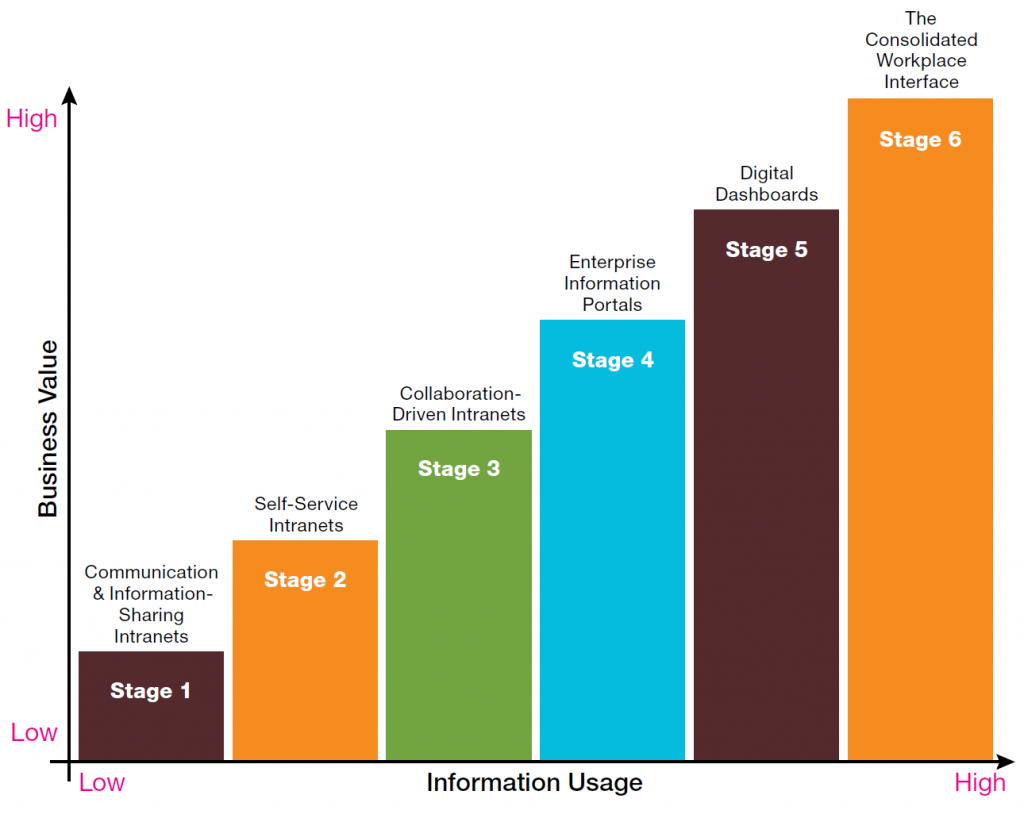
© Avenue A | Razorfish, 2006
For 2006, this model was quite visionary and already described many elements that would be labelled “Digital Workplace” today. At the same time, it highlights one of the fundamental problems of generic Intranet maturity models: in practise, stages 2 to 5 are rarely sequential steps that have to be followed one after the next, but rather parallel developments taking place in accordance to the needs, problems and priorities of an enterprise.
Note: there are of course other, less well known intranet maturity models from that time period. However, I son’t see any additional value in listing here. One modell that might be worth mentioning for German speakers is a modell from 2008 by namics: “Evolution des Intranet Konzeptes“.
The term “Digital Workplace” is very broad and vague by definition, as it is nearly impossible to pin down a concept that encompasses all aspects of (digitally supported) work for everyone.
The first Digital Workplace Maturity Models, like the one designed by Sam Marshall, ClearBox Consulting for the Intranet Benchmarking Forum (published in 2010) jumped in to give a better understanding of what the scope of a Digital Workplace might encompass (rather than trying to give specific direction as to what “the next steps” are).

© Intranet Benchmarking Forum, 2010
This model has been superseded by “The Digital Workplace Map” as shown later on (see also comment by Sam Marshall in the comments section below).
In January 2013 (while still at Infocentric Research), I was asked to create a Digital Workplace Maturity Model for a government client and – in lack of other suitable models available at that time – developed a classic stage concept model:
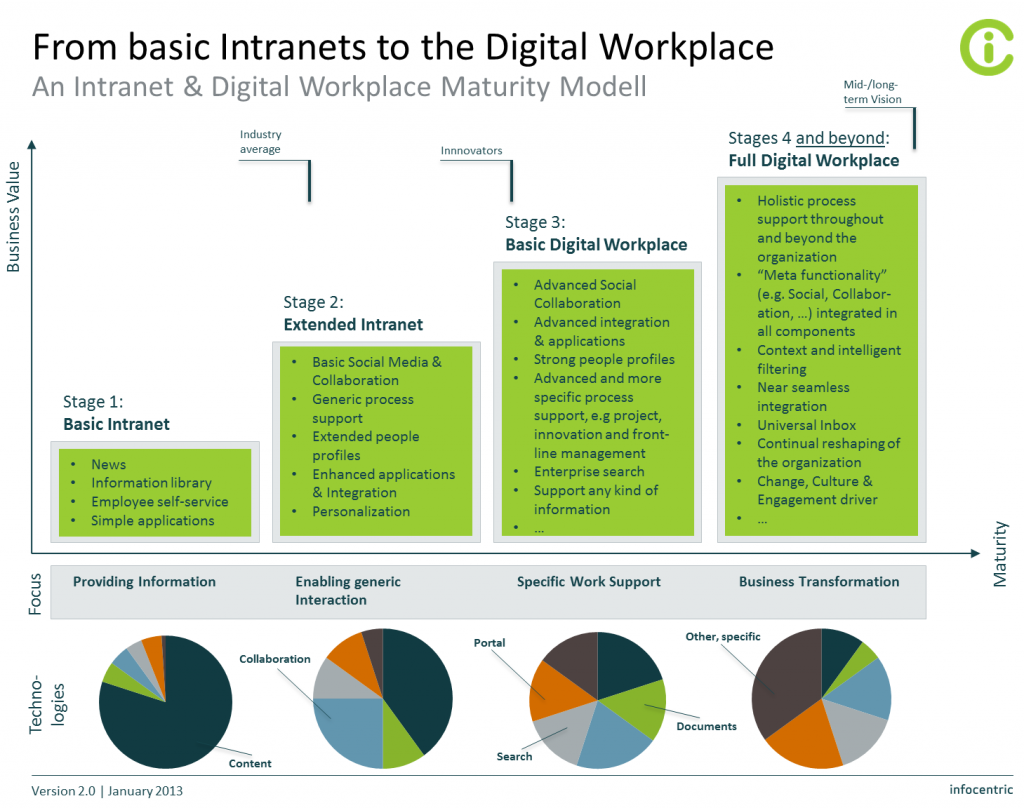
© Inforcentric Research, 2013
First of all, this model tries to draw a demarcation line between an Intranet and the Digital Workplace at the point where more specific work support is offered (beyond general information provisioning, one-size-fits-all collaboration rooms, etc.).
Apart from stage 1, the stages are not defined by which functions are offered, but rather by the total scope of the instrument and by how far the respective support offered goes (e.g. “generic process support” in stage 2 – this could for instance be a simple workflow solution – and “specific process support” in stage 3 – which likely supports far more processes and also in a more specific way, e.g. not just form based workflows).
Lastly, this model tries to give a first impression about the changing composition of the technology portfolio required in each stage. While content management functionality is predominant in stage 1, the later stages are represented by an ever more balanced mix of technology categories.
Shortly after this, the Digital Workplace Group published a maturity model (called “The Digital Workplace Map”) based on the CMMI concept (“Capability Maturity Model Integration”, in which defined areas of e.g. a system are rated on a 5-level maturity scale):
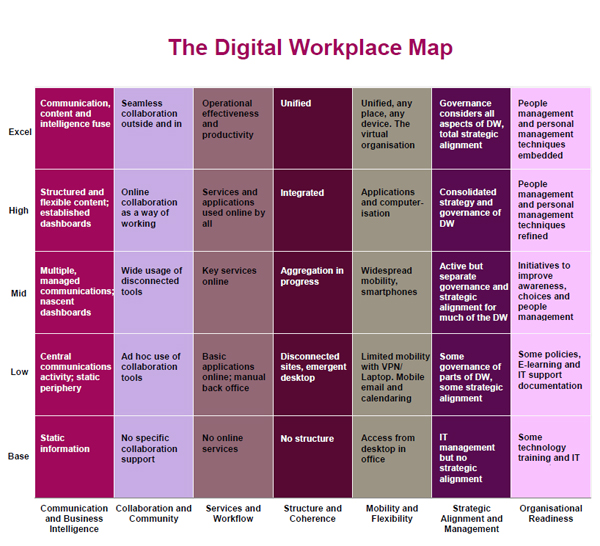
© Digital Workplace Forum, 2013
The “Digital Workplace Map” is divided into seven areas, which are evaluated individually:
A third model comes from Philipp Rosenthal, focusing on the evolution of people in the context of a Digital Workplace. It is called “People Relationship Model”.
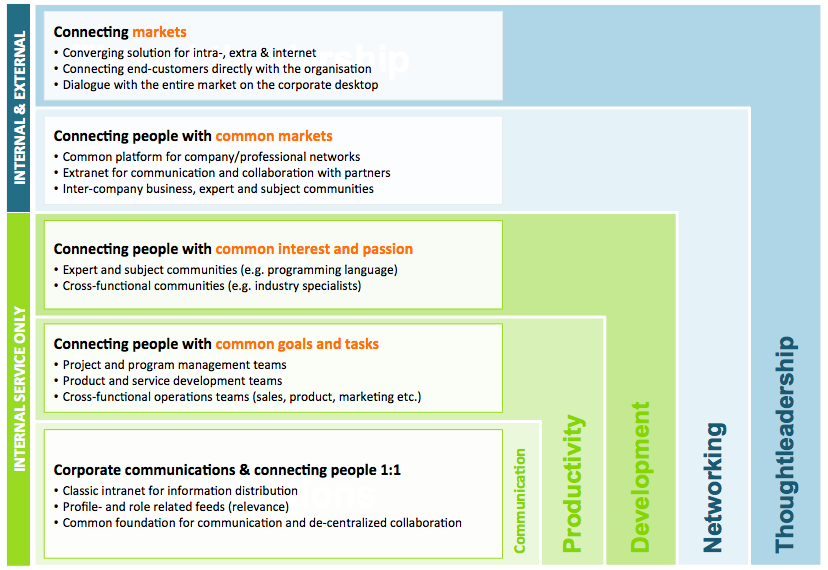
(c) Philipp Rosenthal 2013 (@for_desire_it)
In order to cater for a number of relevant developments and insights since creating the above depicted model from 2013, I started new model in 2014. These have evolved ever since with the current version being 1.8:
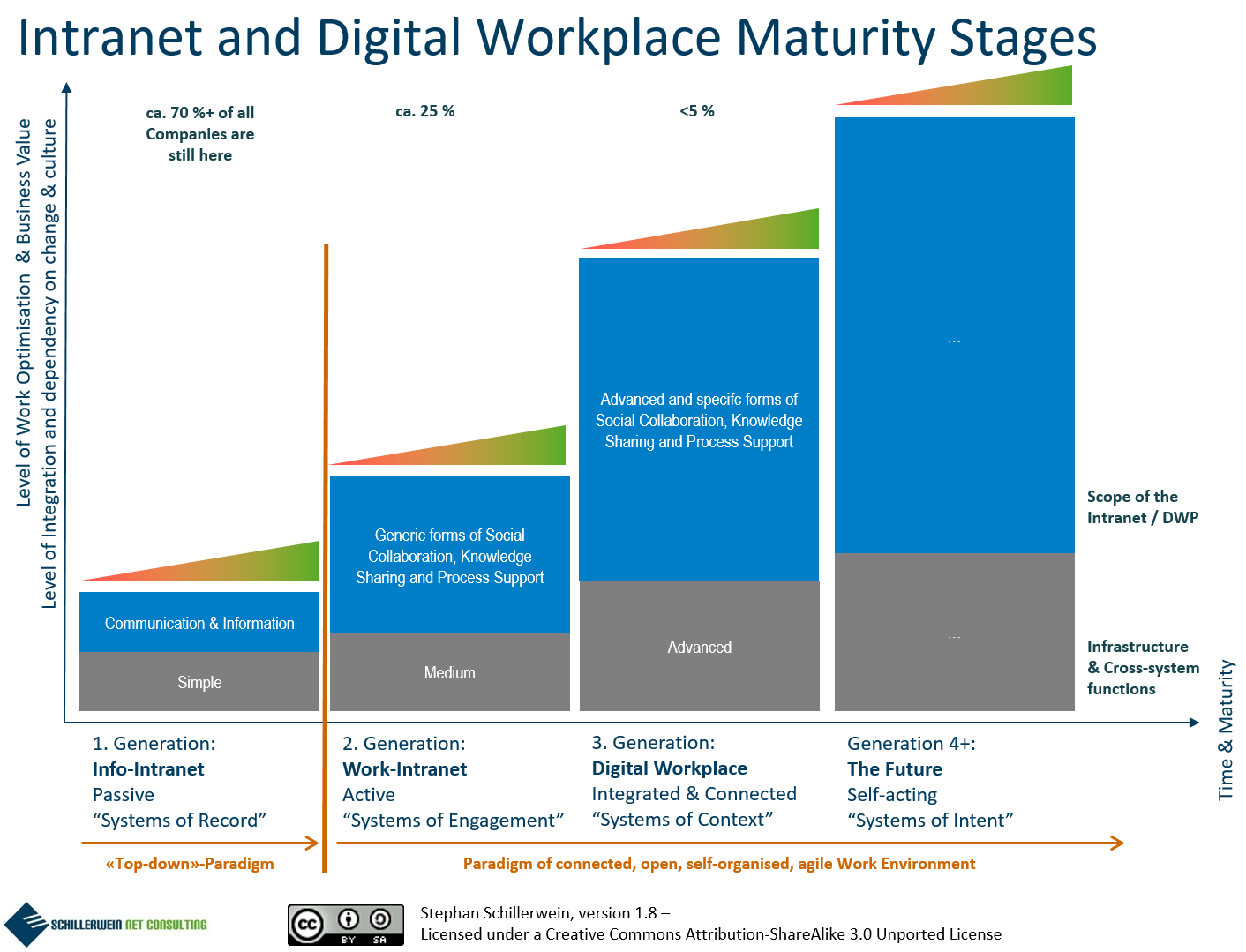
© 2017, Stephan Schillerwein
There is a number of aspects worth mentioning in this modell:
While all models do have different focus, it seems to me that they all reflect the need to cope with the very broad nature of the Digital Workplace (or the changing world of work in general) and therefore have to use a certain level of abstraction that will not easily be understood by all organisations.
On the other hand, this is not really an issue, as such maturity models should only give a first orientation, not a deep dive into an organisation’s current situation or future planning.
If you are aware of other relevant maturity models for Digital Workplaces please use the commenting function below – thank you.
Your email address will not be published.
Required fields are marked *
Monday, May 13, 2013
Intranet & Digital Workplace Maturity Models – Intranet Matters…
This article has been submitted to Intranet Lounge – Trackback from Intranet Lounge…
Friday, August 23, 2013
[…] See on schillerwein.net […]
Friday, November 15, 2013
Please keep informed
Friday, November 15, 2013
Hello,
Please keep me informed of any updates to your Maturity Models.
Kind Regards,
Dr Sami Zahran
Monday, December 2, 2013
Hi Stephan
Thanks for compiling this overview, very useful.
I just wanted to clarify that the ‘nested ovals’ image you show for the 2010 IBF Digital Workplace Maturity Model isn’t the actual maturity model. It was just intended to explain how intranets differ from the wider digital workplace concept. The maturity model itself used 5 levels from ‘Base’ to ‘Excel’, as in the 2013 Digital Workplace Map that you show.
An updated version of the DW Maturity Model report was released this year and is available as a free download (including for non-members of IBF) http://www.ibforum.com/experience-ibf/download-research/from-intranet-to-digital-workplace/
Thursday, July 17, 2014
I feel honored 🙂 thanks
Sunday, July 20, 2014
[…] Intranet & Digital Workplace Maturity Models – Intranet Matters | Schillerwein Net Consult… Very good overview of intranet maturity models. “In the highly dynamic, fast moving world of Intranets and Digital Workplaces, the need for orientation understandably is a big one. Where does my organization stand? Where does the journey go?This overview of Intranet and Digital Workplace Maturity Models is intended to get you started.” […]
Thursday, August 7, 2014
To complete this excellent subject, a first complementary approach through the concept of intranet sociotypes and its matrix with 9 possible classifications
Thursday, August 7, 2014
A second complementary approach through the prism of human resources with the matrix HR postures face to digital tools
Thursday, September 18, 2014
[…] digital workplace is like a gigantic smorgasbord consisting of everything from corporate information, news and phone […]
Thursday, September 28, 2017
A great hybrid of intranet and communication platform. “.. to connect and align their teams, power organizational initiatives and measure the business outcomes.”
Friday, September 28, 2018
Good information. tq